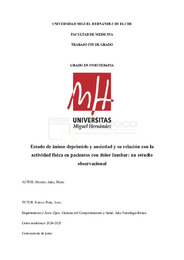Por favor, use este identificador para citar o enlazar este ítem:
https://hdl.handle.net/11000/37539Registro completo de metadatos
| Campo DC | Valor | Lengua/Idioma |
|---|---|---|
| dc.contributor.advisor | Esteras Peña, Jesús | - |
| dc.contributor.author | Morales Arias, Marta | - |
| dc.contributor.other | Departamentos de la UMH::Ciencias del Comportamiento y salud | es_ES |
| dc.date.accessioned | 2025-09-24T11:47:37Z | - |
| dc.date.available | 2025-09-24T11:47:37Z | - |
| dc.date.created | 2025-05-16 | - |
| dc.identifier.uri | https://hdl.handle.net/11000/37539 | - |
| dc.description.abstract | INTRODUCCIÓN: El dolor lumbar es una patología frecuente que genera un impacto significativo en la calidad de vida. Está asociada a alteraciones emocionales como la ansiedad y la depresión, pudiendo afectar al nivel de actividad física. OBJETIVO: Analizar la relación existente entre el estado de ánimo deprimido, la ansiedad y el nivel de actividad física en personas con dolor lumbar, así como observar posibles diferencias según el sexo. MATERIAL Y MÉTODOS: Estudio observacional en el que se utilizaron cuestionarios para estudiar variables sociodemográficas, síntomas depresivos y ansiosos (SA-45), actividad física (cuestionario ad hoc) y dolor lumbar (CBD). RESULTADOS: Tras obtener una muestra de 89 participantes, se pudieron observar correlaciones significativas entre el estado de ánimo deprimido, la ansiedad y el dolor lumbar. No se encontraron diferencias significativas según el sexo en las variables estudiadas. CONCLUSIÓN: La existencia de síntomas depresivos y ansiosos están asociados con mayor dolor lumbar y menor actividad física. Por lo tanto, desde la fisioterapia es esencial abordar el dolor lumbar teniendo en cuenta los factores físicos y psicológicos del paciente. | es_ES |
| dc.description.abstract | INTRODUCTION: Low back pain is a common condition that has a significant impact on quality of life. It is associated with emotional disturbances such as anxiety and depression, which may influence the level of physical activity. OBJECTIVE: To analyze the relationship between depressed mood, anxiety, and physical activity levels in individuals with low back pain, as well as to examine possible sex-related differences. MATERIALS AND METHODS: Observational study in which questionnaires were used to assess sociodemographic variables, depressive and anxious symptoms (SA-45), physical activity (ad hoc questionnaire), and low back pain (CBD). RESULTS: A sample of 89 participants was obtained. Significant correlations were found between depressed mood, anxiety, and low back pain. No significant sex differences were observed in the variables studied. CONCLUSION: The presence of depressive and anxious symptoms is associated with greater low back pain and lower levels of physical activity. Therefore, from a physiotherapy perspective, it is essential to address low back pain by considering both physical and psychological factors of the patient. | es_ES |
| dc.format | application/pdf | es_ES |
| dc.format.extent | 37 | es_ES |
| dc.language.iso | spa | es_ES |
| dc.publisher | Universidad Miguel Hernández | es_ES |
| dc.rights | info:eu-repo/semantics/openAccess | es_ES |
| dc.rights | Attribution-NonCommercial-NoDerivatives 4.0 Internacional | * |
| dc.rights.uri | http://creativecommons.org/licenses/by-nc-nd/4.0/ | * |
| dc.subject | Depresión | es_ES |
| dc.subject | Ansiedad | es_ES |
| dc.subject | Actividad física | es_ES |
| dc.subject | Dolor lumbar | es_ES |
| dc.subject | Fisioterapia | es_ES |
| dc.subject.other | CDU::6 - Ciencias aplicadas | es_ES |
| dc.title | Estado de ánimo deprimido y ansiedad y su relación con la actividad física en pacientes con dolor lumbar: un estudio observacional | es_ES |
| dc.type | info:eu-repo/semantics/bachelorThesis | es_ES |

Ver/Abrir:
TFG MORALES ARIAS, MARTA.pdf
1,32 MB
Adobe PDF
Compartir:
 La licencia se describe como: Atribución-NonComercial-NoDerivada 4.0 Internacional.
La licencia se describe como: Atribución-NonComercial-NoDerivada 4.0 Internacional.
.png)